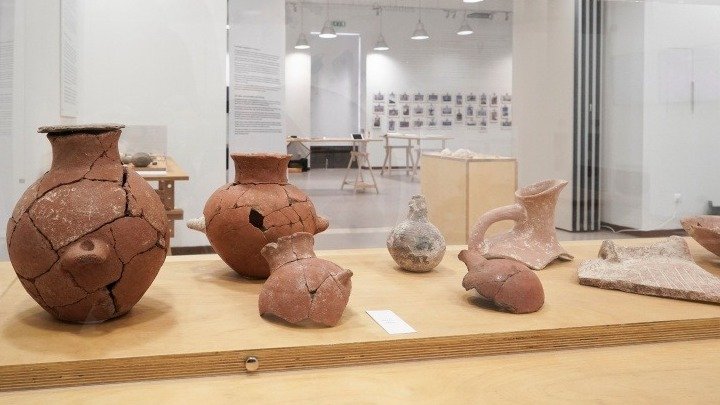An exhibit of archaeological artifacts from Keros and Daskalio - Early Cycladic island sites of 3200-2100 BC - is on show at the Athens Municipal Gallery in the Metaxourgio district of Athens.
The show was inaugurated by Hellenic Republic President Katerina Sakellaropoulou on May 18.
"Des Apenanti - A settlement on Keros of 4,500 years ago" was set up at the Gallery on May 18 and objects in the exhibit were first seen in public in 2019. It includes objects from the long-term excavation by the University of Cambridge at the islets southeast of Naxos, Keros and Daskalio, part of the Koufonissia group of islands. The excavation is under the British School of Athens under permission of the Ministry of Culture.
The exhibit highlights the start of urbanization and the maritime trade networks for raw materials and goods in the Aegean Sea during the prehistoric era. One section shows aspects of daily life and trade, and another provides a glimpse into archaeological methods and documentation, including cutting-edge technologies.
The inaguration was attended by a limited number of guests due to the coronavirus restrictions. They included Athens Mayor Kostas Bakoyannis, Culture Minister Lina Mendoni, archaeologist and curator Stefanos Keramidas and ephor Dimitris Athanassoulis of the Cyclades Ephorate of Antiquities, among others.
Bakoyannis spoke of the numerous objects found on such small sites, and of archaeological information that would "take dozens if not hundreds of books to record fully."
"4,500 years ago Daskalio was not a separate island, but the southwestern-most promontory of Keros," Mendoni said. "At this promontory, archaeologists revealed the oldest island sanctuary, one of the most important prehistoric sites globally, according to Lord Colin Renfrew," she added, referring to the pioneering prehistoric Aegean specialist who has dug there.
"It was clearly the most significant ritual center of the Cycladic Islands in the center of the Aegean from the start of 3000 BC, and definitely nearly 500 years earlier than any other ritual center in the prehistoric Aegean, according to its other excavator, Michael Boyd," the minister added.
Funding for the exhibit was provided by Cosmote, which has been supporting the Cambridge Keros Project.
Entrance to the public is free but visitors must wear a mask. Visiting hours are Tuesday-Saturday 11:00-19:00, Sunday 10:00-16:00. It is closed on Mondays.

